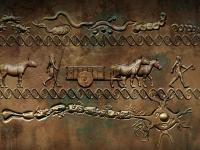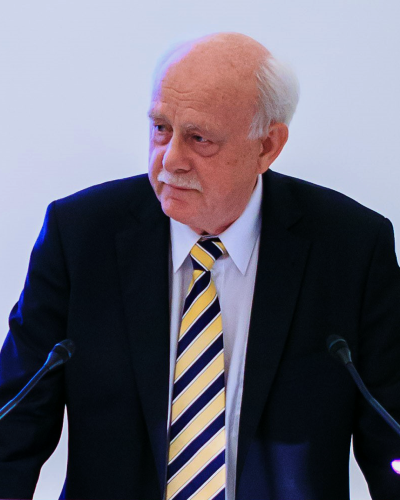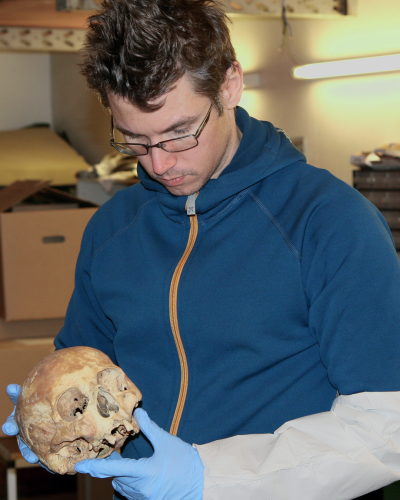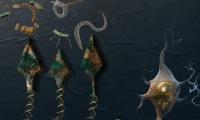NEW LIGHT ON WESTERN EURASIAN PREHISTORY FROM 1,600 ANCIENT GENOMES

In a new study published in Nature more than 1,600 ancient human genomes are analysed to shed unprecedented insights into the past human gene pools of western Eurasia, resulting in several major discoveries of our past.
Population Genomics of Postglacial Western Eurasia is one of four Nature articles and presents the data and premise on which the four studies rely. By analysing a much larger ancient DNA dataset than previously available the researchers were able to show that genetic differences between ancient populations in western Eurasia were substantially higher than previously estimated, and also much higher than observed in present-day populations.
This differentiation was partly because of the existence of an invisible genetic barrier across Europe. Archaeologists have long pointed to an apparent cultural barrier persisting throughout the Mesolithic and Neolithic from the Black Sea in the south to the Baltic Sea region in the north.

Within this geographical region distinct cultural groups had different ways of life in terms of sourcing food, for example. By aligning archaeological knowledge with comprehensive ancient DNA analyses, the identification of this phenomenon of ‘the great divide’ plays a key role in the study.
‘‘Archaeologically, we were well aware that some form of division existed throughout the Mesolithic and Neolithic periods’ recounts Kristian Kristiansen, Professor of Archaeology at the University of Gothenburg, Sweden, and Affiliate Professor at Lundbeck Foundation Geogenetics Centre at the University of Copenhagen (UCPH).
"We knew that people east of The Great Divide maintained complex societies of hunters, fishers, and gatherers, while people west of it gradually became farmers, right up until a watershed in the Bronze Age, around 4,000 years ago, when ‘the great divide’ began to recede. However, what we didn’t know was whether there was genetic difference between the two groups living on either side of it. Now, the analyses of ancient bones and teeth have revealed that there was” explains Professor Kristiansen, one of the co-authors of Population Genomics.
In particular this study provides many new insights into genetic diversity among hunter-fisher-gatherers in western Europe and east of this division. These population structures were changing and the genetic diversity dropped when Anatolian farmers expanded into Europe during the Neolithic and even more when the pastoralist Yamnaya herders spread throughout Europe by 5,000 BP. Morten Allentoft, evolutionary biologist and professor at Curtin University, Australia and Lundbeck Foundation Geogenetics Centre at UCPH, co-led the highly optimised workflow of collecting, sequencing and analysing the many samples of ancient DNA from prehistoric human skeletons reported in the four Nature articles.

Prof., Curtin University, Australia, Associate Prof., Lundbeck Foundation GeoGenetics Centre, Globe Institute, University of Copenhagen, Denmark
Professor Allentoft is first author of Population Genomics, which he and a number of other researchers started preparing more than a decade ago. Even in the preliminary phase it was clear that they faced a significant preservation challenge with these samples, being up to more than 11,000 years old.
‘The ancient DNA in many of the samples was degraded in the extreme. But because we were able to draw on our experience and technological breakthroughs in terms of both sampling and extracting DNA from a similar major study on the Bronze Age, we were now able to go even further back in time and analyse more than 300 genomes dating back to the Mesolithic and Neolithic’ says Professor Allentoft. These data could then be combined with existing published data to build our amazing dataset of more than 1600 ancient human genomes.
When asked what surprised him most during the study, Professor Allentoft is quick to answer: ‘That would be the genetic mapping of The Great Divide, and the fact that distinct genetic differences endured for so long among the people living on either side of it. That finding was thrilling for me.’

To map whole genomes from the heavily fragmented ancient DNA the researchers relied on a method known as imputation. This is an advanced mathematical model that allows researchers to fill in the gaps of patchy ancient genomes. The predictions from the model are based on analyses of a very large number of complete genomes from present-day individuals. Using imputation, researchers can reconstruct missing sequences with a precision that makes the ancient human genomes usable for large-scale population genomic analyses. ‘It’s important when working with these reconstructions to have access to state-of-the-art techniques within DNA technology, including imputation. We had that, and it really made a difference,’ says. Martin Sikora,
He is an associate professor specialising in population genetics at The Lundbeck Foundation Geogenetics Centre and The Globe Institute at UCPH and worked closely with Professor Allentoft for years to uncover these results. In the Population Genomics study, Dr. Sikora’s task was to lead many of the large-scale analytical components including finding genomic traces of three major migration events that occurred during and after the Mesolithic and Neolithic in Western Europe, including in Denmark:
‘We were largely familiar with the genetic traces of these three migrations. But we still had a great many unanswered questions concerning all the important details: Who were the people behind these migration events? How did they mix with the locals? Where and how did these transforming events originate?,’ Dr. Sikora explains.
THE RATIONALE BEHIND THE DIVISION
Over the years, various theories have been posited to account for aforementioned cultural division. One proposes that the mainland climate of the region east of the divide did not favour agriculture, so the inhabitants maintained their traditional hunter-fisher-gatherers way of life for much longer.
While climate may have played a role, the explanation is more complex than that, believes Professor Kristiansen, who points to the culture that prevailed among the hunter-fisher-gatherers east of The Great Divide:
‘These were very well-organised and socially advanced societies that also had elites, such as a warrior class, and had learnt to make pottery and knew about food preservation. Equally, there would have been enough food in the form of fish in rivers, and wild animals in the forests, so there wouldn’t have been much incentive for giving up this way of life. In my opinion, this is the main reason to account for the longevity of The Great Divide until 4,000 years ago when a new warrior elite west of this invisible border, from a region between Scandinavia and Ural, headed eastwards on plundering raids in chariots drawn by domesticated horses. These vehicles were the equivalent of present-day tanks, and the hunter-fisher-gatherers and their otherwise highly developed communities were unable to defend themselves against them,’ says Professor Kristiansen.
Adding to the enigma, Population Genomics shows that the genetic division actually arose long before, while people on both sides of this invisible barrier were still hunter-gatherers. So clearly it was not only the introduction of agriculture that was a dividing factor in creating this dynamic.
SPREAD IN NO TIME
The migration routes of the Yamnaya herders, whose ancestry we can find in large proportions in present day Europeans, are also mapped in Population Genomics. As such, understanding the Yamnaya origin and spread is crucial to understand the genetic origin of Europeans.
Professor Kristiansen explains that in genetic terms, we can see that the Yamnaya arose as a population mix between hunter-fisher-gatherers east of The Great Divide and people from Caucasus living along the river Don. They inhabited the Pontic Steppe in parts of what are now Ukraine, South-West Russia and the West Kazakhstan Region, and the Yamnaya were the world’s first nomads.’ Professor Kristiansen continues:
‘They had ox-drawn carts covered like prairie wagons and would have been able to move around the Steppe with their livestock, and in that sense would have been the first to exploit and develop the Steppe economically. They were not farmers as such, but on their migration from the Pontic Steppe, in Eastern Hungary, north of the Carpathians, they learnt to cultivate barley from the local population. They brought that know-how with them on their great push towards Northwestern Europe, which they reached around 4,850 years ago.’
The new discoveries published by the team show that Yamnaya people mixed with people from a cultural group known as Globular Amphora culture and then spread across Europe very fast. “It only took about 50 years to end up in Bohemia and disperse over the almost 900 km between the Netherlands and the Limfjord in Northwestern Denmark, " Professor Kristiansen explains.
‘And wherever they came, they cleared forest by slash-and-burn to practise semi-farming with a few crops, typically barley, and keeping livestock such as oxen and sheep.’

Part of the theme